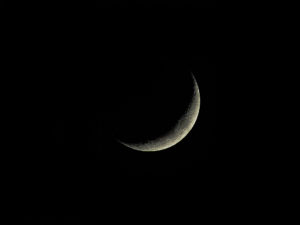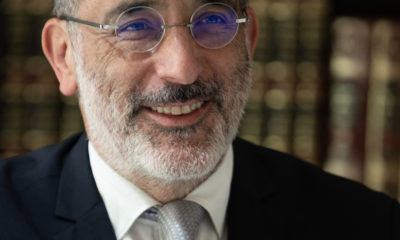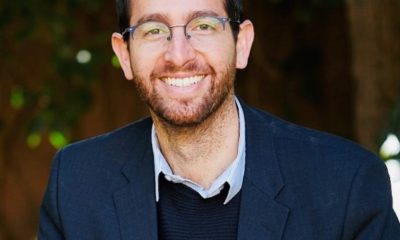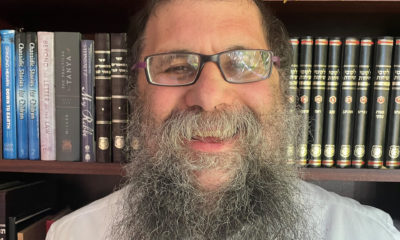
Religion

Rewriting our song under a dark moon
I’m in a Rosh Hashanah state of mind and there’s a song that’s been playing in my head: “I am unwritten/can’t read my mind/I’m undefined” sings Natasha Bedingfield in her 2004 hit Unwritten. She continues, “I’m just beginning/the pen’s in my hand/ending unplanned”. Bedingfield couldn’t have known it, but her glorious hit captures a profound potential of the Jewish new year: every year we have the chance to “fade to black” and renew ourselves “anew”.
The rabbis in the Talmud, Rosh Hashanah 8a-b, cite a source from Tehillim (81,4) to describe the timing of Rosh Hashanah. “Tiku vachodesh shofar, bakeseh leyom chageinu” (Sound the shofar on the new moon; the concealed moon is the day of our festivities).

Indeed, Rosh Hashanah is the only Jewish holiday to begin on the new moon, when the moon is but a speck in the sky, an imperceptible sliver in darkness. The verse in Tehillim continues, “For this is a statute for Israel, a judgement for the G-d of Jacob.” These two verses juxtaposed present a paradox; our Day of Judgement begins in a time of visual obscurity, when the moon is occluded, except for the tiniest sliver.
It might seem counter-intuitive that at a time of teshuvah, introspection, inner work, and G-dly judgement, the light is dimmed and vision impeded. The medieval midrashic work Pesikta Rabbati offers a reason for this: just as the moon is dimmed on Rosh Hashanah, on the Day of Judgement, Hashem chooses to “not see” our sins.
This beautiful idea suggests that the judgement of Rosh Hashanah isn’t about utter scrutiny. Rather, G-d is rooting for us on Rosh Hashanah, so much so that G-d would choose the darkness of the moon rather than see our flaws.
Rosh Hashanah, the Day of Judgement, isn’t about G-d simply weighing up the good and the bad on a scale, it’s about G-d dimming the vision, creating a soft focus so that G-d can see us in a particular way, for good!
This gives us a clue that Rosh Hashanah isn’t about microscopic examining of ourselves, and it shouldn’t feel critical and punitive. In fact, Rashi explains that the new moon of Rosh Hashanah isn’t utter darkness. Rather, it’s such a thin sliver, that it’s both there and not there. To see this inchoate new moon, we need soft focus, gentle vision.
The idea of seeing ourselves differently, kindly, is developed by Michael White and David Epston in narrative therapy. Non blaming and non pathologising in nature, narrative therapy encourages clients to look at the stories we use, in order to heal and live our lives.
Some of the stories we carry are empowering and liberating while the others we tell about ourselves might be untrue, restrictive, and unkind. Narrative therapy helps us to undo the unhelpful stories so that we can free ourselves to live in greater authenticity.
The dark moon of Rosh Hashanah is our own narrative therapy. It invites us all to let go of the scripts that no longer serve us, the habits and ideas about ourselves and the world, so that we can begin again.
In the verse from Tehillim, the shofar is linked to the concealed moon, “Blow the shofar on the new month … when the moon is concealed.” The Hasidic thinker, the Sefat Emet, Rabbi Yehudah Leib Alter of Ger, points to the purity of the shofar blasts, and how its sound is devoid of speech.
He says speech divides sound into varied movements of the mouth while the sound of the shofar is a united sound that cleaves to source. The Sefat Emet suggests that on Rosh Hashanah, we seek to connect to the inner flow of life, to the source that precedes division.
The time of Rosh Hashanah, the dark moon, is the time of soft focus, inviting us to undo fixed and unhelpful scripts and ideas. The sound of Rosh Hashanah, the shofar, is “a cry from the heart that the lips cannot speak”. In other words, the shofar takes us in this time of concealment to our deepest longings.
The poet Keats writes, “So the darkness shall be the light/and the stillness the dancing.” Rosh Hashanah invites us to let go of preconceived notions of ourselves so that we can allow our deepest longings and our fullest selves to surface. But we need to allow for the darkness and the opacity of the new moon, to surrender brightness and clarity of vision, and sit in the swirling, opaque mists of our potential.
Poised at the beginning of 5783, this feels particularly resonant for me. For almost 20 years, I have lived in South Africa, worked, raised our family, and connected with community.
This Rosh Hashanah, I’m preparing, with my family, to leave South Africa on an adventure to another country. We’re in the heart-wrenching throes of saying goodbye to beloved family, friends, and a country that means so much to us.
And we also don’t know the contours, the story of our new life. Indeed, we’re sitting with the hidden moon and we’re blowing the “unwritten” sounds of a wordless shofar. This is, perhaps, the only way for new life to unfold.
Next week, we’ll sing “Berosh Hashanah yikateivun” (On Rosh Hashanah it is written). This time of soft vision, wordless sounds, and open hearts allows us to release the stories that diminish us, and seek the stories that allow for our souls to unfold. In the words of Natasha Bedingfield, “Today is where your book begins/The rest is still unwritten.”
Shanah Tovah. May we and all our loved ones be written and sealed in the Book of Life
- Adina Roth is a clinical psychologist who runs a barmitzvah and batmitzvah programme and other Jewish studies classes. She is about to move to Sydney to become Head of Jewish Life at Emanuel School.










